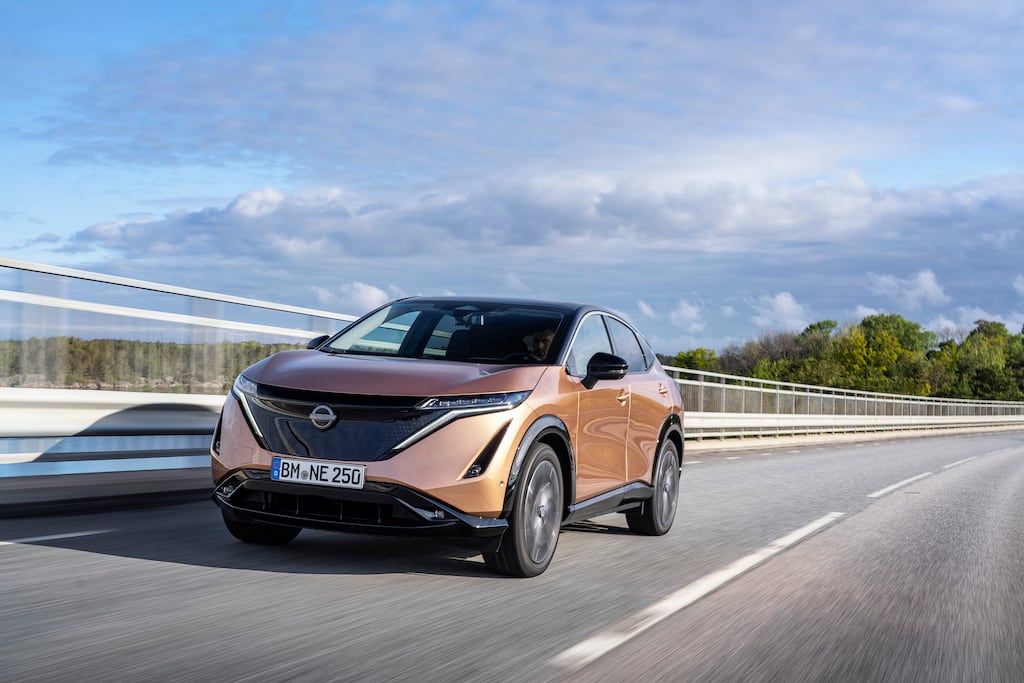The Nissan Leaf was the first, of that we can be fairly sure. Not the first electric car (rewind more than 120 years to find that) nor even the first recent EV on sale, but that bulbous, fish-faced 2012 Mk1 Leaf was unquestionably the first electric car to really matter to people. It may have had a paltry 160km range (and rarely even that in the real world) at first, but people bought it, it won the European car of the year prize, and it kick-started – albeit with a certain amount of lag – the electric car revolution that is only now truly gathering pace.
Nissan, having had such a massive lead on rivals in terms of experience, should have made good on the Leaf’s promise. At least you’d have thought. But no – although a better, longer-ranged second-gen Leaf duly arrived, there were no other all-electric Nissans on sale. Even as VW launched multiple models across its multiple brands, even as Tesla grew to unimaginable proportions, even as Johnny-come-lately Ford brought out its Mustang Mach-E, Nissan waited.
That wait was as much to do with aligning platform and battery developments across the Nissan-Renault Alliance, as well as dealing with the outfall from Covid, as it was anything else but finally, here we are in 2022, driving what is only Nissan’s second all-electric nameplate.
Instantly, it renders that original Leaf pretty antediluvian. If the Mk1 Leaf was the battery equivalent of a Ford Model T, then the Ariya is a Space Shuttle, and even looks a little like that famous Nasa craft, when finished in a mixture of black and white. Get it in all-black and it looks like Darth Vader’s company car…
A Ukrainian in Dublin: ‘People are less direct in Ireland. There are 50 shades of great’
Prostate cancer: ‘When you hear ‘inoperable’, your world falls apart. But soon I realised that didn’t mean terminal’
Vogue Williams: ‘Spencer ran towards me with red flags hanging off him in every direction’
Ireland’s rising rents: ‘Our budget would have been €1,300 a month, there isn’t even anything listed for that’
Where the Ariya really shows up the old Leaf, and to a barely lesser extent the current Leaf, isn’t in its battery range or charging abilities – although these are manifold. No, it’s in the cabin where the Ariya makes a massive jump forward, not merely relative to the Leaf but to pretty much any Nissan model.
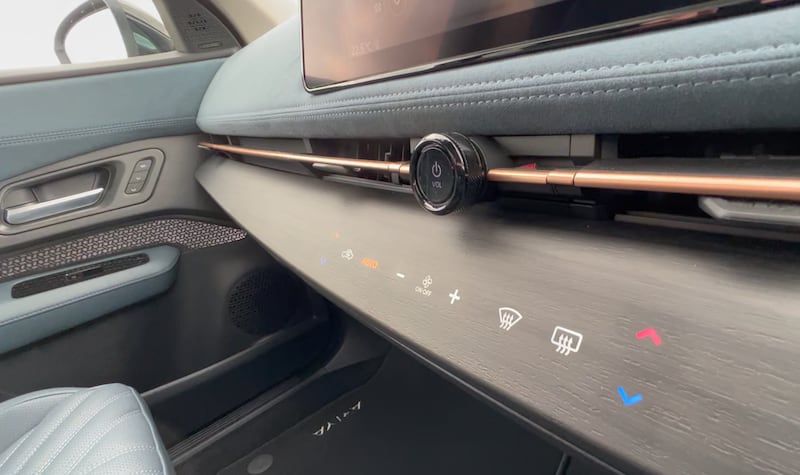
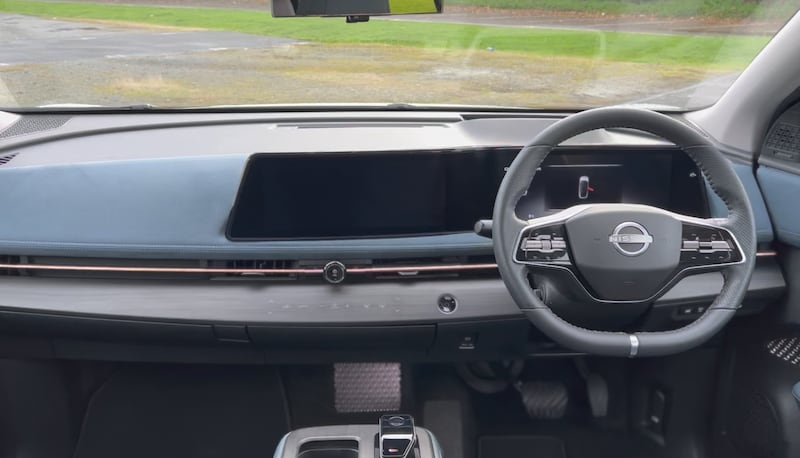
In fact, with its soft-touch buttons, big screens, suede trim, blue leather seats and sense of hefty quality, the Ariya could stand comparison with any of BMW’s current electric models. Only the graphics of the screens – which look a little cheap and free-app-ish – let the side down.
Not that there aren’t some quirks in the cabin. The centre console, on which you’ll find the gear selector, some touch-sensitive buttons for the driving modes, the one-pedal driving function and more, motors back and forth electrically… and I really can’t work out why. It means that the rear heated seat switches are a little less of a stretch for passengers in the back, and it gives front-seat occupants access to a couple of USB sockets and a very slim, very shallow storage but that’s about it. Why this had to be expensively engineered to whirr electrically back and forth is a bit beyond me.
Of more use, and much more fun, is the centre glovebox, which is also electrically powered and which you can open, revealing a bag of jellies for your son who’s just come out of school, and say in a robotic voice: “Your Haribo, young master…”. Hours of fun.
Those touch-sensitive buttons, which are repeated on the centre of the dash as heating and air conditioning controls, are slightly odd too. They look great, but they require a more definite prod than you expect, meaning that any technical advantage over conventional switches is pretty narrow. They do look good, though.
So too do the blue leather seats, which look very inviting but which are a little narrow and, if you’re me, set a little too close to the roof lining. That slight lack of headroom is compensated for by excellent legroom front and rear. The 466-litre boot is decent rather than outrageously spacious, but it helps that it gets the useful moveable floor panels from the Qashqai, and that you can stash the luggage cover under the floor when it’s not in use.
To drive? You really need to keep it in Sport mode, which is rather anathema to an electric car driver. Usually, you’d instinctively leave it in Eco mode, to eke out the battery range but if you do that the Ariya feels a touch top-heavy and slightly whispy. Tune it over to Sport, though, and the sharper steering response makes it feel far more enjoyable to drive, giving it a feeling of swishy agility, and to be honest you’re not really losing much in the way of battery range.
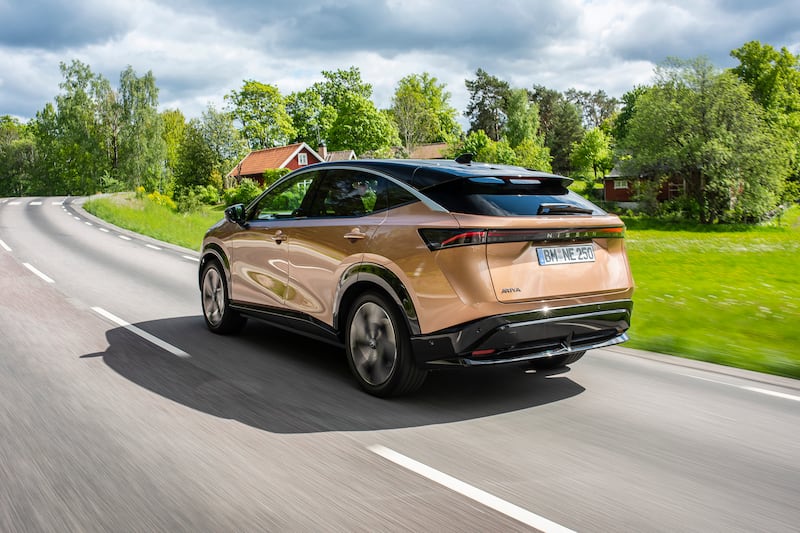
That range, for this top-spec 87kWh Evolve model, stands at a claimed 532km, but in our hands it would rarely indicate more than 400km on a full charge. Much of the blame for that (quite apart from driving in Sport mode a lot) can be ascribed to it being cold out, and me not being able to charge at home and pre-heat the cabin on a chilly morning. Even so, the Ariya carried out my usual long motorway run from Belfast to Dublin without breaking an electric sweat, using about 50 per cent of its charge to do so.
This Evolve model is pricey, to say the least – at €66,990 it’s a price match for the long-range version of the Ford Mustang Mach-E and the newly arrived Volkswagen ID. Buzz. Thankfully, you can get a much more affordable model, with a 63kWh battery and a claimed 400km range, for €48,995, which is cheaper if not exactly cheap.
Should you? Yes, you should. The Ariya is a car that’s far more competent, all-round, than many of its rivals not least because it has a touchscreen that actually works and separate buttons for heating and air conditioning (although conversely we could never get the rather reticent automated parking aid to lend a hand). It cruises quietly and comfortably, for relatively long distances, and feels engaging to drive when the road becomes more challenging. Plus, you can speak in a robot voice while making a secret drawer appear as if from nowhere. Who wouldn’t want to do that?
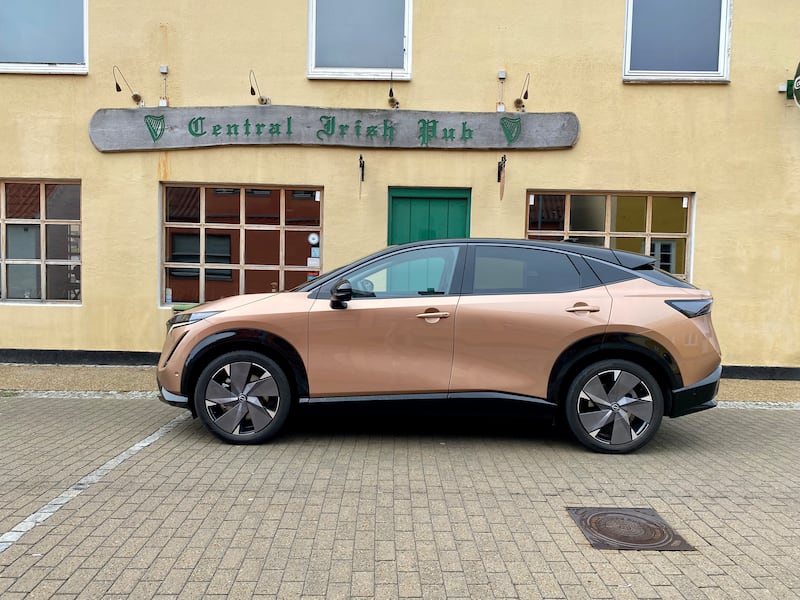
Nissan Ariya 87kWh Evolve: the lowdown
Power: 178kW electric motor developing 242hp and 300Nm of torque, powering the front wheels wheels via a single-speed automatic transmission.
CO2 emissions (annual motor tax) 0g/km (€120).
Electric consumption: 19.6kWh/100km (WLTP).
Range: 532km (WLTP)
0-100km/h: 7.6sec.
Price: €66,995 as tested, Ariya starts from €48,995.
Our rating: 4/5.
Verdict: Stylish and practical, with a long range and a gorgeous interior.
